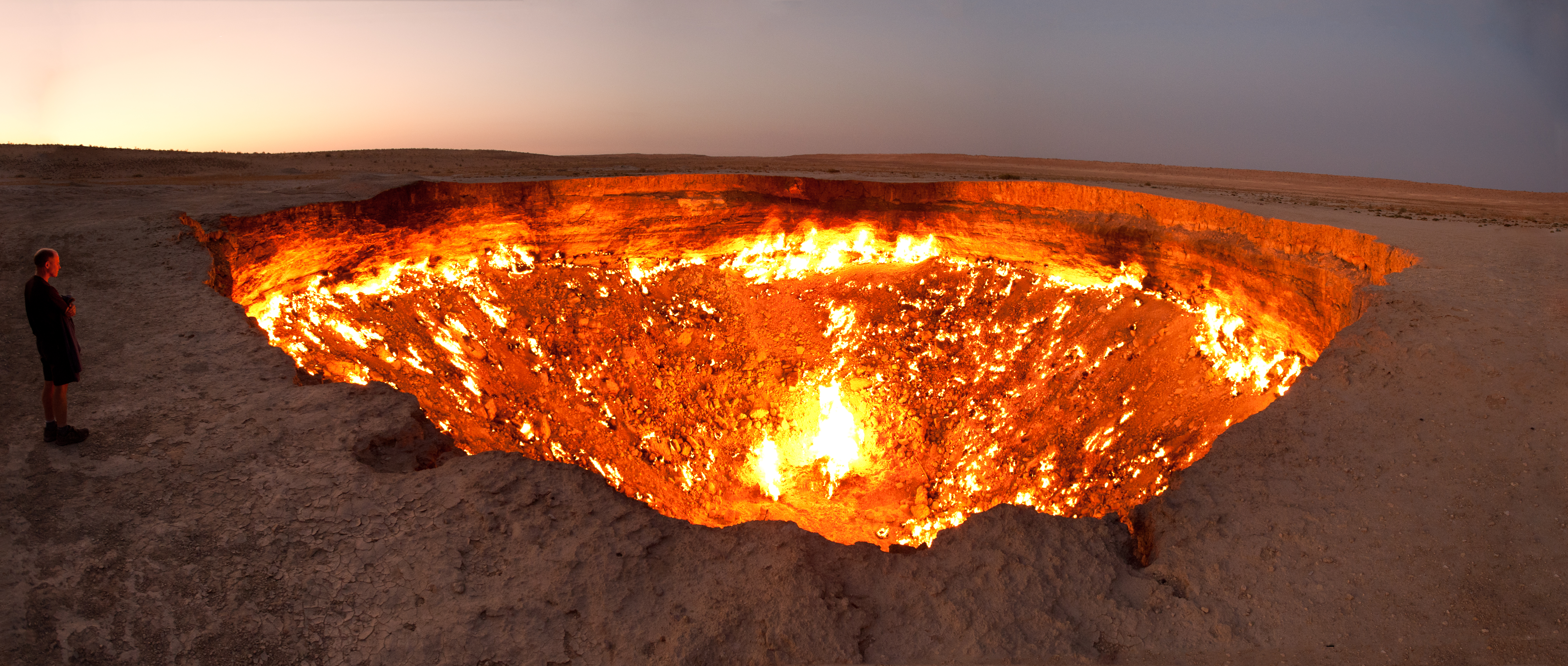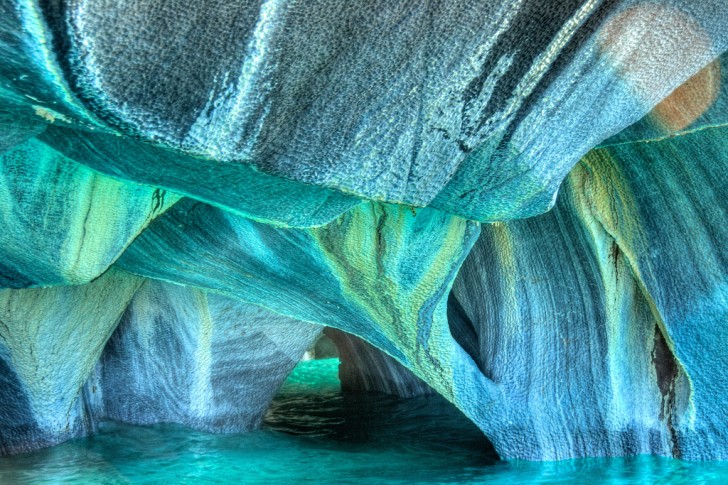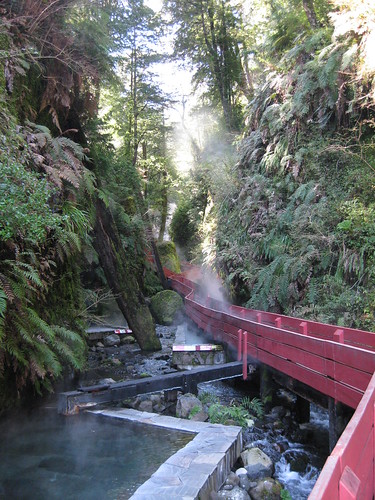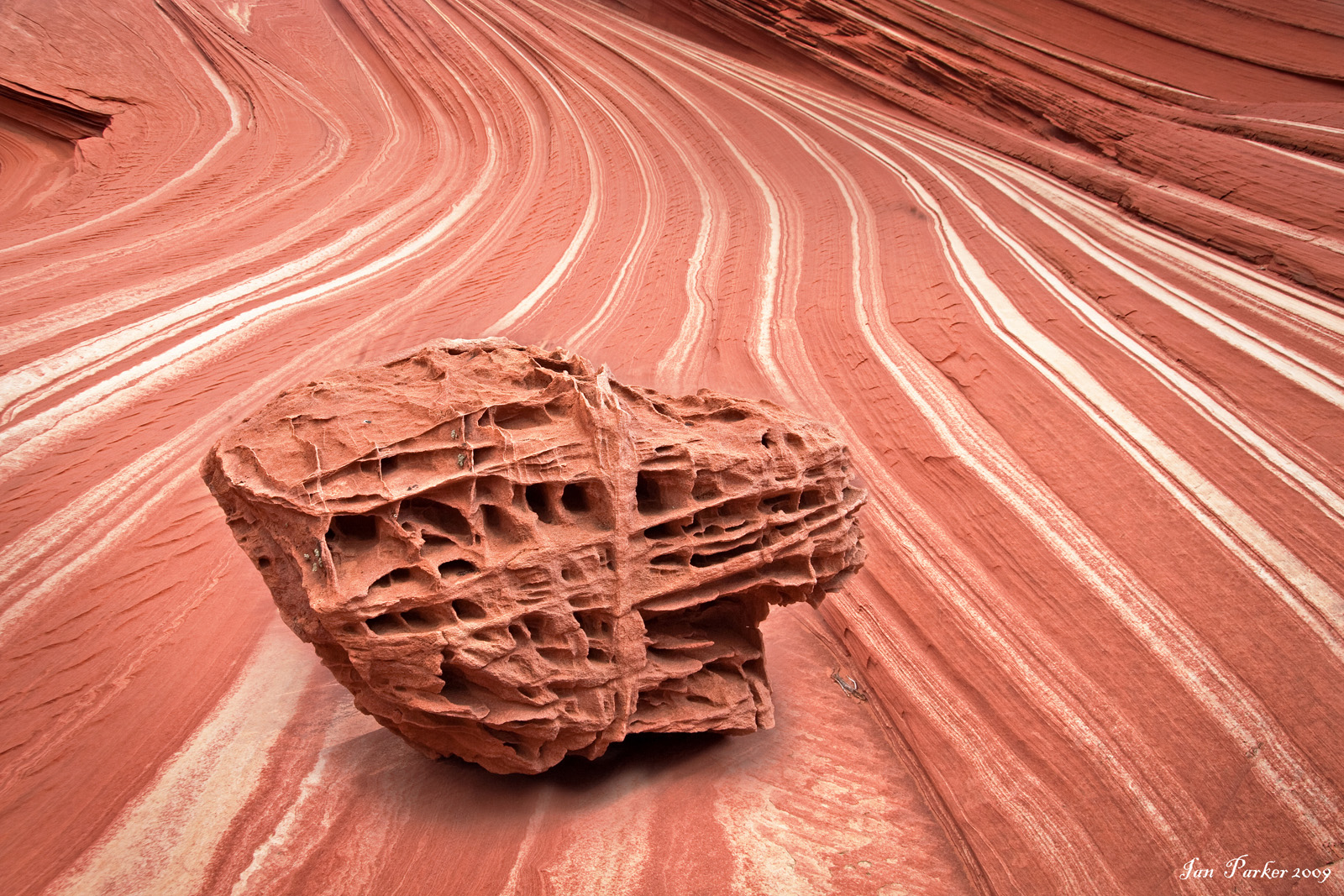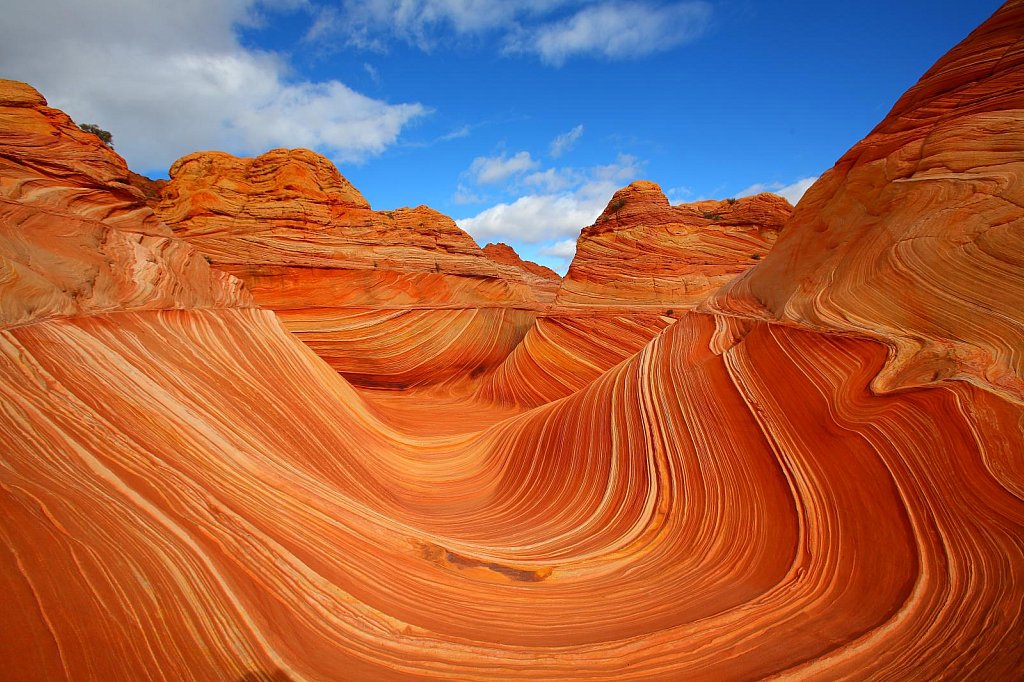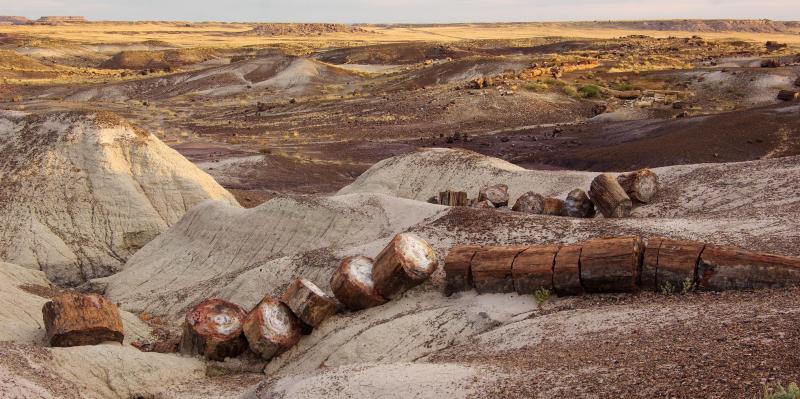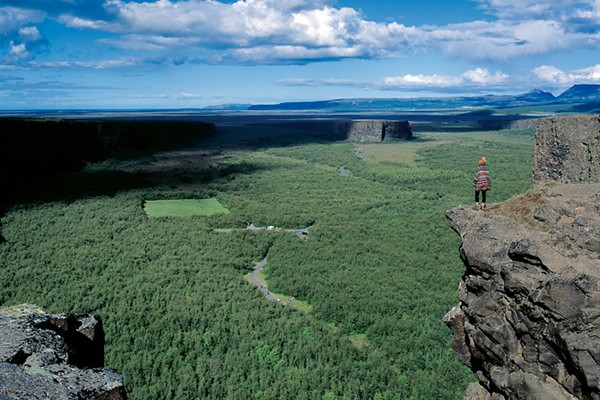Nothing says "end of 2014" like fire!
Someone breached a gas field and set it on fire. I'd love to go see this. I suspect this'd make exploration drilling in the area quite tricksy.
Darvasa gas crater aka Doorway to Hell. Picture by Tormod Sandtorv, Image grabbed from wikimedia.
Wednesday 31 December 2014
Wednesday 24 December 2014
Places I've been - Jan Juc Marl, Otway Basin
Bioturbation // burrows in the Jan Juc Marl. A marl is a calcium rich mud and the Jan Juc Marl is early Ogliocene - early Miocene in age and is defined as a fine-grained silty glauconitic marl with sandy calcarenite interbeds which coarsens upwards.

My learned friend, Shannon Hurley, suggests these overlapping and diverging burrows are Chondrites. She proposed that the circular burrow (cross-section) pictured below my finger is Thalassinoides.
Ophiomorpha?
Wednesday 17 December 2014
Date Ideas: 17/12/2014 - Canadian Rockies, Alberta, Canada
Many, many things to see here. Todays selection is glacial fed, Lake Morain in Banff National Park.
 Lake Morain at Night by Andrey Popov.
Lake Morain at Night by Andrey Popov. Wednesday 10 December 2014
Date Ideas: 10/12/2014 - Azul Macaubas quarry, Brazil (counter top geology)
I haven't seen this rock in person but the images I've found on the web make it a must see / must have. It seems to be a quartzite with a delicate blue colour introduced by dumortierite. The website that sells it is flash so not so good for getting images from however you should have a flick through their page (clunky though it is) - here. This is sold as Azul Macaubas, or sometimes Blue Marble. It looks best as large pieces such as bench tops. I think I need a bath made out of this, or a swimming pool maybe. Tiles would work beautifully as well.
I got the below image from here, and my structural geology brain went wow - look at those refolded folds!
Labels:
azul macaubas,
Brazil,
Counter top geology,
Date idea
Friday 5 December 2014
Otway Basin - wildlife
As something a little different, wildlife seen while looking at sediments in the Otway Basin - at least the animals I was excited about seeing!
Tiny scorpion hanging out on the siltstone.
 |
| Echidna butt |
Wednesday 3 December 2014
Places I've ben - Eumeralla formation, Otway Basin
Last Thursday I took a trip to the Otway Basin with the Monash 3rd year sedimentary short course students. It was a lovely day and we saw some beautiful outcrops. The Eumeralla Formation is volcanilithic sandstone, siltstone, mudstone, mud-clast conglomerate,
with feldspar and quartz grains, and coal: fine to medium grained,
consolidated, well-bedded, cross-bedded; braided stream deposits. It was deposited the same time as the Inverloch sediments in a similar environment.

Faulting with minor offsets - sandstone with finer grained, organic rich beds
A scour filled with muddy rip-up clasts, some spotted this trip were up to 20cm wide.
Wednesday 26 November 2014
Date Idea: 26/11/2014 - Yucatan, Mexico
Cenotes (sinkholes and cave systems) in Yucatan, Mexico. Image and good explanation of the features to be found from this blog.
Wednesday 19 November 2014
Date Idea - 19/11/2014 - Patagonia, Chile
Marble Caves of Patagonia, Chile. Photo credited to Robert O'Duill on this website
Wednesday 12 November 2014
Date Idea - 12/11/2014 - Termas Geometricas, Chile
Because you might as well relax and enjoy yourself if you're planning on spending sometime looking at rocks I present: Termas Geometricas near Pucon in Chile. It offers a range of springs in a natural setting (some with waterfalls) for approximately $40 AUD per person. It's on the list!
Image from here - a pretty good website full of things to see and do in Chile.
Wednesday 5 November 2014
Places I've been: Inverloch Pt 3 - Fossils!
Tiny mammal jaw found at Inverloch - image by Steve Morton (Monash University)
The dinosaur dreaming digsite at Flat Rocks, Inverloch is a rather special as it has yeilded over 10,000 fossils from a time when the rift was developing between Australia and Antarctica. I find one of the most significant to be a tiny mammal jaw (above) which is smaller than a fingernail. It is due to this fossil that all material removed from the fossil rich layer must be broken into sugar cube sized chunks before being assessed for fossil material.
Map of fossil locations courtsey of the Dinosaur Dreaming website.
The fossils themselves are found in a flood deposit / conglomerate which formed as part of a braided river environment, now called the Strazlecki Group. A large variety of fossils have been found in this region (above) and I'm told the small greyish lump in the photo below is one such fossil fragment.
Also found in this area (but away from the fossil extraction site) are a set of dinosaur footprints. Located on the shore platform, they are slowly erroding and probably won't exist in a couple of years. This year I took a picture with my camera case for scale. The footprints are outlined in a slightly darker sediment and feature two three towed footprints overlaid on each other. The feet themselves are about 1.5x bigger than mine (see my hiking shoe toe for scale as well)
If you want more information about this site, or are interested in joining the team at the dig on their next summer campaign, checkout the dinosaur dreaming website. If you want some awesome pictures of some of the fossils they've recovered, this post by Tom Rich on The Conversation has some great images.
Monday 3 November 2014
Counter top geology - Serpentine
I spotted a broken slab of serpentine at the Kilsyth Bargin Centre the other day. It hasn't photographed amazingly well because it's polished but it was a rather nice sample. Not what I'd pick for a bench though, a little soft for longevity.
The broken end showing the polished section (deep green) and the talc-y greasiness of the rock
The broken end showing the polished section (deep green) and the talc-y greasiness of the rock
Saturday 1 November 2014
Historical places I've been: Tower Hill Maar, Victoria
It's been a while since I've done one of these. This is an image of Jim Driscoll and I at the Tower Hill Maar in Western Victoria, 2013. He's into sedimentology and geothermal research and is just about to finish his PhD at Monash University. For the last couple of years we've assisted with the JMSS geology field trip and this is one of the locations we take the students.
This is a nested maar system is the result of a sequence phreatomagmatic eruptions (note the huge number of layers behind us) resulting in a complex structure seen today. Multiple scoria cones are surrounded by a crater lake (which is probably formed by multiple vents). The countryside around Tower Hill is covered by these ash and scoria layers which all slope gently away from the site of the volcano.The volcano also ejected larger bombs, the impact of one can be seen over my right shoulder. The shape of these craters can help determine the trajectory of the bomb and allows volcanologists to determine the sequence in which the vents were actives.
This is a nested maar system is the result of a sequence phreatomagmatic eruptions (note the huge number of layers behind us) resulting in a complex structure seen today. Multiple scoria cones are surrounded by a crater lake (which is probably formed by multiple vents). The countryside around Tower Hill is covered by these ash and scoria layers which all slope gently away from the site of the volcano.The volcano also ejected larger bombs, the impact of one can be seen over my right shoulder. The shape of these craters can help determine the trajectory of the bomb and allows volcanologists to determine the sequence in which the vents were actives.
Wednesday 29 October 2014
Places I've been: Inverloch Pt 2 - Chrono-turbation
The faulted cliff just to the east of the stairs has some very interesting sedimentary structures, the bulbous shapes in the middle of the above image. Each year, for the benefit of the students, we have a debate over the formation of these features. I tend to fall into the chrono-turbation camp. The basal shape of the structures suggests that the lower, unconsolidated, layer of mud was frozen (permafrost). When it was overlain by a denser mud, it eventually thawed and the heavier mud pushed down into the underlying sediment creating these bulbs.
The other camp is the bio-turbation camp.
The other camp is the bio-turbation camp.
If this were bio-turbation the 'burrows' are quite sizeable (digital camera case for scale), so either this is one kick-ass worm-critter, or the smaller dinosaurs were in the habit of digging burrows to a very uniform depth (which could also be explained by permafrost i guess). To me, the lack of fossilised bedding material rules out habitation burrows so if these were burrows they were temporary structures.
This image is of the structures, top down. While there isn't really enough exposure, I feel this looks more like weathered load casts than bio-turbation. I encourage you to visit the shore platform and the cliffs around Inverloch and make your own decision.
Next up: Fossils!
Next up: Fossils!
Wednesday 22 October 2014
Places I've been: Inverloch Pt 1 - Structure
Looking all safe in my super-dooper safety vest!
Last weekend I participated in the annual pilgrimage to Inverloch with the first year geology students. This trip combines everything they've studied this semester into one convenient location - fossils, rock type identification and sedimentary rock naming conventions, sedimentary structures and current indicators and basic structural geology. I'm going to present some of the interesting things spotted at the site in the following posts, for now let's look at my favourite - structural geology!
 |
|
| Normal faulting with massive sandstone on the left and mudstone on the right | Fault drag locally bends the beds of the mudstone. Slicken can be seen in the sandstone on the left. |
Most of the faulting is this region is normal and associated with the failed rift between Tasmania and Victoria which created the Bass Straight.
A close up of the faulted sandstone - Stay tuned for Park II - Chrono-turbation!
Bonus image - the demonstrating team from 2010 (Chris, Julie, Roland, Kim and I) with bonus beard, knitted and carpeted by my mother for my birthday, it was COLD that day!
Labels:
Inverloch,
Places I've been,
Sediments,
Structural Geology
Sunday 12 October 2014
Science with Amber
Spider in Amber shamelessly linked from here.
My interest in geology started with my Grandfather who still travels to Andamooka to mine opals. He used to go once a year and it was his private time away from his (in my opinion) huge family (5 kids + some ring-ins at times). When I was a child he would occasionally craft jewellery for us from opals or other crystalls that caught his attention. After many years of dabbling at University I finally found the geology department and started my own research. Once facet of this was to research how opals were formed so I could help him (theoretically) stake out his new patch each year.
During this time, he also taught me the basics of silver smithing. This combined with my interest in medieval things led me to play with amber. I recall one of my first attempts went horribly wrong. I had epoxied my cut and polished amber into a setting and chipped the stone while I was tightening the claws. So I thought I'd just dunk it in nail polish remover (like I did opals) to soften the epoxy and recut the stone. (clearly I wasn't thinking). The amber, being a resin, also went soft and squishy. Oops! I have toyed with the idea of seeing if I can soften amber, push inclusions like bugs into it (or squish two pieces together) and then re-harden them but I haven't gotten to that experiment yet.
One of the experimental amber samples
In summary - I like amber, I like science and the following paper combines the two and may even help me in future purchases. Experimental studies on the heat treatment of Baltic amber. Yamei Wang, Mingxing Yang, and Yiping Yang. Gems & Gemology, Summer 2014, Vol. 50, No. 2
Friday 10 October 2014
Wednesday 8 October 2014
Wednesday 1 October 2014
Counter top geology - Rapakivi granite
Large (up to 6cm) circular orthoclase feldspars (pink) phenocrysts with growth rings of opaque minerals (hornblende?). Many of the feldspars have a plagioclase feldspar (green) rim. Some also display a growth ring of plagioclase. The rest of the granite consists of large (1cm) crystals of dark minerals and orthoclase.
Small growth rim of plagioclase suggests alternating temperature/chemistry of the melt?
This granite is located on the side of Bran Diamonds on Swanston Street, Melbourne. It's one of my favourite facias in the city. I always thought it was a lovely weathered example of orbituclar granite however when confirming it's origin I found this page and this page both of which suggest this is in fact Rapakivi Granite.
Wednesday 3 September 2014
Date Idea 3/9/2014 - Vermilion Cliffs, Arizona
According to Beautiful Places to Visit.com, permits are required to access the vermilion cliffs and only 20 are issued each day. Looks like a beautiful sedimentary landform. I'd love to go explore this properly - look at that unconforrmity!
Wednesday 27 August 2014
Date idea 27/8/2014 - Petrified Forest
I've spent some time teaching at the Fossilised Forest on the shore platform at Inverloch, Victoria. It's quite a sight to see huge tree trunks that have been knocked over in a flooding event and preserved with the mud still clinging to the rocks. I've recently found out about an even more impressive fossilized trees - The Arizona Petrified Forest (http://www.nps.gov/pefo/index.htm). Not only does this place have a forest of preserved trees, it also has some amazing fossils too.
Wednesday 20 August 2014
Date Idea 20/8/2014 - Icelandic volcanos
I've probably posted about Iceland already, but all geologists should visit this country - where else can you stand on a divergent plate boundary AND the results of a mantle plume? I recently got linked this update about recent activity and the possibility of another large volcano.
Wednesday 13 August 2014
Date Idea 13/8/14 - Meteorites
Having read a post on geology.com regarding starting a meteorite collect, I've deiced that hunting meteorites might make and enjoyable date activity. Not only can this be done anywhere (some places are better than others), there are also many different types to collect!
A couple of the researchers at Monash University go out to the Nullibore to hunt meteorites. This location has some distinct advantages. Due to the limited erosion and weathering, meteorites are preserved in-situ for a long long time. This increases the chances of finding them. Other locations that would be productive are known strewnfields. Areas where meteorite fragments have already been found where more might be discovered. Recently, 10th July 2014, a meteorite was seen from Melbourne and Sydney (as reported in The Age newspaper). It was recorded by a number of people. A meteorite this recent would be amazing to find.
Subscribe to:
Posts (Atom)
